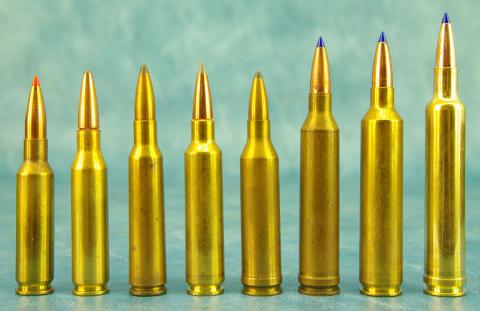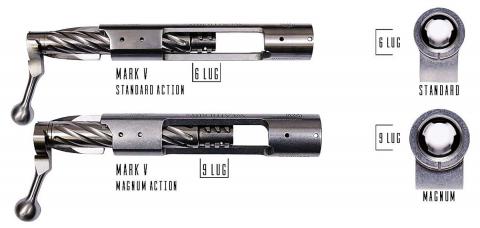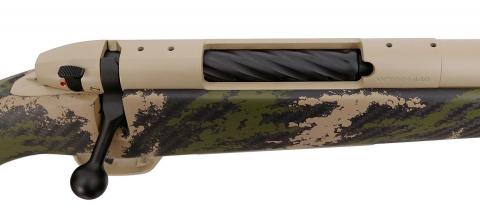6.5 Mania
Am I the only one suffering from 6.5 overload? If you haven’t heard by now, Weatherby has introduced another 6.5mm cartridge — the 6.5 RPM (Rebated Precision Magnum), along with a new Titanium iteration of its excellent Mark V standard size action. I say another because just two years ago they introduced the 6.5-300 Weatherby Magnum, a cartridge which, as its moniker indicates, is derived from necking down the .300 Weatherby case to .264-inch. According to factory ammo specs, it can lay claim to be the fastest commercial 6.5. But before we take a look at the new RPM and its host rifle, the Mark V Backcountry, I think a brief review of the 6.5’s history on these shores in is order.
Prior to the introduction of the .264 Win. Magnum in 1958, the only 6.5 to achieve any measure of popularity here in the U.S. was the 6.5×55 Swedish Mauser that was adopted by the Norwegian Joint Military Commission in 1894. Though it remains a highly popular cartridge in Europe to this day, especially in Scandinavian countries, it was virtually unknown here until the 1950s when inexpensive military surplus rifles and ammo became available. When compared side-by-side with the .260 Remington, which was introduced in 2002, the Swede’s 25-degree shoulder actually makes it a more modern case design, and one that has virtually the same powder capacity and, assuming handloads in modern rifles, the same performance potential. Unfortunately, like the 7×57 Mauser, factory ammo ballistics for the 6.5×55 are unimpressive because unless otherwise noted, it’s loaded to lower pressure levels for safe functioning in surplus Swedish Mausers and Krags.
When the .264 Win. Magnum was rolled out in 1958, it generated an excitement among hunters like few cartridges before or since. In conjunction with the Model 70 Westerner rifle with its 26-inch barrel, a velocity of 3,200 fps was claimed for the 140-grain factory load. The gun writers of the day heaped praise on this screamer of a cartridge, claiming it adequate for elk, the big bears and all African plains game. It was not, however, popular for NRA High Power and other forms of long range competitive shooting, which at the time was nowhere near as popular as the phenomenon it has become today.
Fast-forward to 1962 and Remington’s introduction of its 7mm Magnum. To put it bluntly, the Big Seven pretty much killed the .264 to the point where in 2012, because no major American rifle manufacturer was chambering for it, it was listed as obsolete in the 4th edition of the Ammo Encyclopedia. In 1966 Remington gave the 6.5 a shot with its 6.5 Rem. Magnum, but it and the Model 600 Carbine chambered for it were discontinued after just three years for lack of interest.
So, from the mid-`60s to around the turn of the century, the 6.5 was largely neglected by the hunting fraternity. Even after the .260 Rem. was introduced, the needle didn’t move much in the direction of the .26 caliber. After all, it was a distant second to the .264 in performance, and performance, i.e., velocity, is what hunters wanted.
Within a couple of years, however, a groundswell in interest was growing for long-range shooting. As counterintuitive as it is, long-range competitive shooters were discovering that smaller calibers of modest case size and moderate recoil were just as accurate at 1,000 yards and beyond as the .300 magnums, which for so long had been de rigueur.
In 2001 Norma decided to adopt the popular wildcat 6.5-284, which by then had begun making a name for itself in 1,000-yard competition. With the launching of the .260 Rem. the following year, we now had four commercial 6.5s from which to choose.
Came 2007, Hornady announced its 6.5 Creedmoor, the first commercial cartridge to be designed expressly for NRA High Power and 1,000-yard competitive shooting, though by no means limited to those pursuits. Hardly an instant success, it took a few years for the Creed to establish itself as a world beater, but in so doing it focused attention on the 6.5 cal. in general to the point where there is even a revival of interest in the obsolete 6.5 Rem. Magnum and the moribund .264 Win. Mag.
So successful was Hornady’s brainchild that 2018 could justifiably claim to be the “Year of the 6.5 Creedmoor,” for by then “Now in 6.5 Creedmoor” was emblazoned on the cover of every makers’ rifle catalog. And makers of AR-10 platform guns were just as eager to add the caliber to their chamberings. For AR-15s the 6.5 Grendel was developed and it has become quite popular. Not content to sit on its laurels, that same “Creedmoor Year” Hornady rolled out another moderate-level competition-oriented .26 with its 6.5 PRC (Precision Rifle Cartridge). By then, Hornady alone was offering 10 loadings for the Creed, more than any other cartridge in their catalog, save the.308 Win.!
While all this was going on, Nosler decided to cash in on the 6.5 craze, but with one they felt would appeal to hunters looking for an extreme range hunting cartridge. Thus in 2015 we got the 26 Nosler, a hell-breathing magnum that in three factory loads pushes two 140-grain bullets and one 142-grainer at 3,300 fps in a cartridge that cycles through a standard-length action.
Not to be outdone, Weatherby countered the following year with its 6.5-300, a cartridge that can rightfully claim to be the king of the 6.5s. Requiring a magnum-length action, the 6.5-300 Wby. bests the 140-grain Nosler load by 95 fps.
That brings us up-to-date and to the 6.5 RPM. With this cartridge the company broke tradition in several ways. First, it’s not based on a belted case; rather, it’s a lengthened version of the .284 Winchester, retaining the original’s rebated rim of .30-06 size (.473”), with a larger head diameter of .500”. And instead of the radiused or venturi shoulder seen on all other Weatherby cartridges, the RPM retains the 284’s angular 35-degree shoulder.
Also, the long leade or free-bore throating heretofore found in all Weatherby rifles chambered for Weatherby cartridges is not found in the new Mark V Backcountry in this caliber. Rather, it’s throated “similar to other modern cartridges” to quote from the catalog. Here’s how this latest Weatherby stacks up against its big brother and other 6.5s: Note there is no current 140-grain Hornady factory load for the 6.5 PRC, so we’ve used the 143-grain ELD-X in the data table below. Knowing a 140-grain load will surely be added this year, we can assume at least 3,020 fps for the 3-grain lighter bullet.
- 6.5-300 Wby – 140 Gr A-FRAME – 3,395 fps
- 26 Nosler – 140 gr AccuBond – 3,300 fps
- 6.5 Wby RPM – 140 Gr. AccuBond – 3,075 fps
- 6.5 PRC – 143 gr ELD-X – 2,960 fps
- 264 WIN MAG – 140 gr AccuBond – 2,940 fps
- 6.5 -284 NORMA – AccuBond 140 GR – 2,750 fps
- 6.5 CREEDMOOR – 140 GR ELD-Match – 2,710 fps
- 260 REM – 140 GR A-FRAME – 2,655 fps
- 6.5×55 – 140 gr – 2,550 fps*
*factory loads suitable for military surplus rifles
As for the two new Weatherby rifles being chambered for the 6.5 RPM, they’re the Backcountry and Backcountry Ti, both of which are built on the little known but quite excellent Mark V “Standard” action. Essentially, the Standard Mark V is a scaled-down version of the Mark V Magnum. As such, both bolt and receiver are lighter and smaller in diameter, and scaled to cartridges of .30-06-length (3.340”) and head diameters of (.473”).
Instead of the nine locking lugs found on the Magnum’s bolt, this more svelte version has six. As its name suggests, the Backcountry’s raison d’etre is light weight, and contributing to that goal is a spiral-fluted bolt, a scalloped bolt sleeve and a hollowed-out bolt knob. Naturally, the stock is a carbon fiber composite; the 4-groove 1-8” twist barrel is of slender contour and comes standard with a 1/2×28 threaded muzzle fitted with a Slim-line Accubrake.
Other standard features are a TriggerTech Mark V trigger and Weatherby’s patent pending 3D HEX recoil pad. All these features combine to deliver a rifle that weighs 5.3 lbs. in Backcountry version, and 4.9 lbs. in the Titanium-actioned Backcountry Ti. The former carries an MSRP of $2,499; the latter $3,349.–Jon R. Sundra





